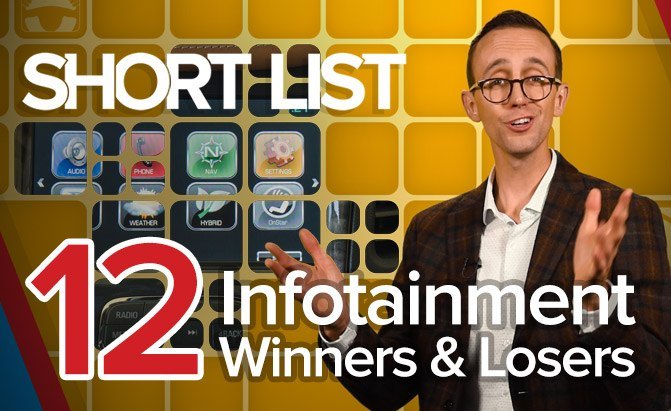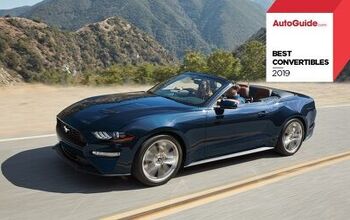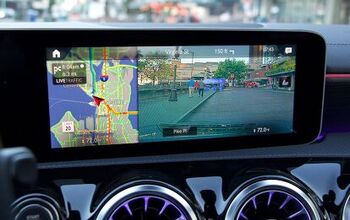Infotainment System Winners and Losers - The Short List

Get the Flash Player to see this player.
Today’s cars and trucks contain more circuity than a Foxconn factory.
From sensors and actuators, to switches, displays, relays and microchips, they are nothing less than rolling computers. And certainly, a major reason for this electronics explosion is the proliferation of infotainment systems, some of which are far better than others.
It’s crazy how modern vehicles offer so many features and amenities. Even in the 1990s some base-level pickup trucks only came with an AM radio; highfalutin’ FM was optional. Don’t even ask about a tape deck!
Jump forward a quarter century and drivers expect even the most affordable cars to come with some sort of infotainment technology. Automakers have risen to the occasion and there are TONS of these systems on the market today. And here’s what we, the staff of AutoGuide.com think is best and what needs work.
WINNER: FCA Uconnect
Starting things off, an easy recommendation is FCA’s Uconnect system. Fast and intuitive, it’s been a winner since day one. Available in a variety of flavors in a huge range of vehicles from the tiny Jeep Renegade to heavy-duty Ram trucks, it’s versatile and offers all the functionality you’d expect, like in-vehicle Wi-Fi, support for Amazon Alexa, over-the-air updates and more.
WINNER: Porsche Communication Management
Next up, the latest version of Porsche Communication Management, PCM for short, which our own editor-in-chief Jodi Lai has raved about. In the new Cayenne, it features a huge 12.3-inch widescreen display on the dashboard. Bright and crisp, it also supports common smartphone gestures like swiping and pinch-to-zoom. But more importantly, the menu structure is super intuitive, which goes a long way toward minimizing driver distraction. This sport-tuned, luxury utility vehicle also gets Porsche Advanced Cockpit, a reconfigurable digital instrument cluster with two seven-inch screens flanking an analog tachometer. For even more choice, Apple CarPlay is supported, though Android Auto is not.
ALSO SEE: 2019 Porsche Cayenne Review
WINNER: Ford Sync 3
A certain Dearborn-based automaker has made significant infotainment strides in recent years by replacing its always-sluggish, often-buggy MyFord Touch system with Sync 3, which is far faster and appreciably easier to figure out. Like Uconnect, its layout is dead simple, plus it offers a variety of apps like NPR One, Spotify and even Waze. As you might have guessed, Android Auto and Apple CarPlay are both supported.
WINNER: MMI with Audi Virtual Cockpit
Audi’s Multi Media Interface, MMI for short, has been one of the industry’s leading infotainment systems, offering lots of functionality while still being relatively easy to use.
SEE ALSO: 9 Things to Know About the 2019 Toyota Corolla Hatchback – The Short List
Elevating their game, in recent years it’s gained support for handwriting recognition and boasts of a simplified arrangement of function keys around its main control knob. But the real show is Audi Virtual Cockpit, which replaces traditional analog gauges with an immersive – and reconfigurable –display. With so much eye candy, it’s hard not to love this setup, which is offered in many four-ring models, from the small A3 sedan on up.
UNDECIDED: Volvo Sensus Connect
Moving forward, let’s highlight a few undecideds, a handful of infotainment systems that show promise but ones we can’t quite fall in love with.
And we start with Volvo Sensus Connect. At first glance, the latest version of this multimedia technology looks like a winner, with its gigantic portrait display and fairly minimalistic home screen. But poke around for a little while and you’ll probably find the performance a bit lacking and interface cluttered.
UNDECIDED: BMW iDrive
It’s a similar story with BMW’s pioneering iDrive system. The latest versions offer TONS of functionality, from remote software updates to Microsoft Office and Skype integration, you can even interact with it in multiple ways: the traditional control knob, the touchscreen, voice commands or even gestures. It’s all a bit overwhelming. And perhaps that’s its main weakness, offering too many features.
UNDECIDED: Chevrolet MyLink
Chevrolet’s MyLink system is far simpler in comparison, but still, it’s never really wowed any of us. It mostly works alright, though some of the graphics are hideous, with more shine than a glazed doughnut. Overall, it’s not a bad bit of kit, but it’s not our favorite.
LOSER: Toyota Entune 3.0
But now for a few losers, infotainment systems that just can’t compete with the industry’s best.
Despite a reputation for building top-quality vehicles, Toyota really seems to lag in the field of multimedia technology. Entune 3.0 is the brand’s latest and greatest system. It’s offered in the Avalon, where I experienced it most recently, plus the Camry, Sienna and Mirai. To be polite, it’s a complete mess, with a user interface that’s catastrophically obtuse. Thank the Lord Almighty God in heaven Apple CarPlay is supported… FINALLY.
ALSO SEE: 2018 Honda Accord vs Toyota Camry Comparison
LOSER: Lexus Remote Touch
And even if you pony up the cash for a Lexus, things aren’t much better. This luxury brand’s Remote Touch Interface is despised by both Jodes and our news editor Sam McEachern. I’m not quite as vociferous in my disdain for it, but I agree with them, it sure ain’t worthy of much praise. The trackpad/mouse system is perhaps the most frustrating interface on the market. It never does what you want it to and is far too distracting while driving.
LOSER: Infiniti InTouch
Another disappointment on this list of winners and losers is Infiniti InTouch, an infotainment system with two screens for twice as much confusion and difficulty!
SEE ALSO: 7 Differences Between the 2019 GMC Sierra and Chevrolet Silverado – The Short List
I recently experienced this setup in the brand’s racy Q60 coupe and found it to be rather chaotic. Navigation is located up top, while the lower display is home to the climate-controls, audio system and a variety of vehicle settings, many of which are buried under layers of menus. Making things worse, each user interface looks like it was designed by a different team on an entirely separate continent. Toss in a weird mix of hardware and software buttons and you end up with a big “NOPE!”
LOSER: Nissan Connect
NissanConnect has no fans here, either. In the Titan at least, it looks like something from about 1998, with gritty graphics and a byzantine UI. I’ll pass on this one as well, thanks.
LOSER: Subaru Starlink
Subaru’s Starlink infotainment technology hasn’t won the AutoGuide.com editors over, either. Now, they may have improved things in their more recent models, but performance has been a major issue in our testing. There’s simply nothing fast or fluid about it, a shame, really.

Born and raised in metro Detroit, Craig was steeped in mechanics from childhood. He feels as much at home with a wrench or welding gun in his hand as he does behind the wheel or in front of a camera. Putting his Bachelor's Degree in Journalism to good use, he's always pumping out videos, reviews, and features for AutoGuide.com. When the workday is over, he can be found out driving his fully restored 1936 Ford V8 sedan. Craig has covered the automotive industry full time for more than 10 years and is a member of the Automotive Press Association (APA) and Midwest Automotive Media Association (MAMA).
More by Craig Cole












































Comments
Join the conversation
Craig should start testing other systems more from mainstream cars. Kia and Hyundai's system is better than Audi's, and Toyota's new system is infinitely better than Mazda's (though I understand since Craig's bias for Mazda is pretty well-documented, hence Mazda's omission from this article). I'll also take Nissan's system over Mitsubishi's any day.
Infotainment systems are distracting. So far every study has that conclusion. What happens when it dies out if warranty? How long will the manufacturer support the infotainment and digital dashboards? If either dies after the parts support window is the vehicle a throw away item? Fancy proprietary software and hardware seem to be a guarantee the vehicle will be replaced sooner than later.